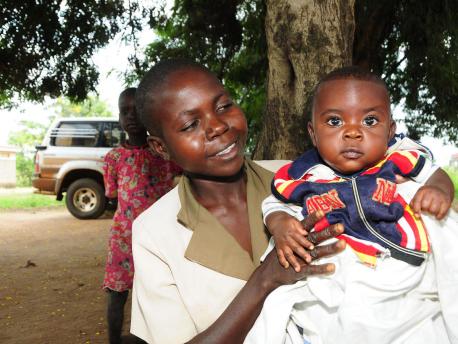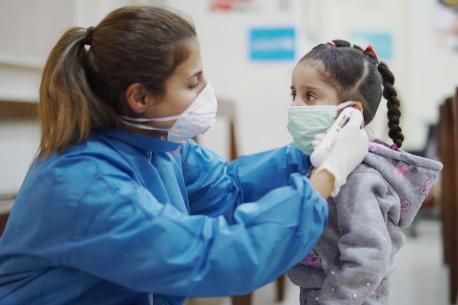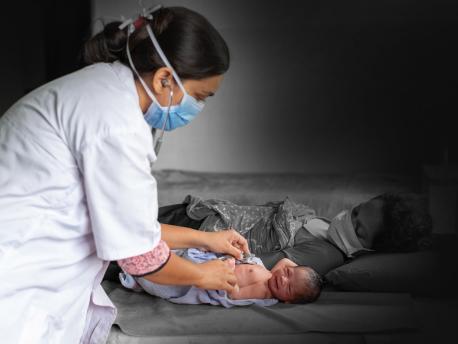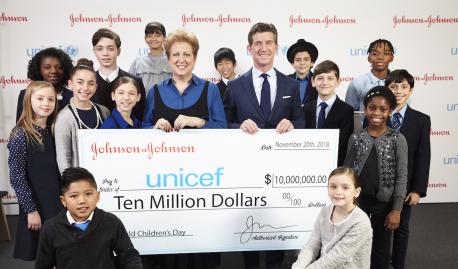
Delivering Health Care on the Front Lines
UNICEF and Johnson & Johnson's 30-year partnership has helped hundreds of thousands of women and children worldwide.
Every day, more than 15,000 children under age 5 die from preventable causes. UNICEF and partners like Johnson & Johnson promote high-impact health interventions for mothers and children globally. Go Blue on World Children's Day to protect children's rights around the world.
The biggest challenges that face the world won't be solved by a single organization or a single group of people working in just one country. To tackle today’s most pressing concerns, scientists, designers, doctors, technologists and academics — to name but a few — must come together for good to create innovative solutions to today’s problems. That’s why UNICEF’s Global Innovation Center (GIC) partners with Johnson & Johnson (J&J) to deliver cutting-edge health solutions to those who need it the most.
For more than 30 years, UNICEF and J&J have worked together in 20 countries and territories to improve the lives of hundreds of thousands of women and children and their families. A new $10 million commitment from J&J will support and train frontline health care workers to potentially save thousands more lives globally. By establishing UNICEF as an enterprise-wide global partner, J&J is demonstrating its commitment to putting the health of children first, and helping every child thrive.
We caught up with Dr. Joanne Peter, Health Technology Lead for J&J’s Global Community Impact team, to find out why she believes such partnerships are important and what has been achieved so far.
Tell us about the work that you lead at J&J and how this collaboration with GIC fits in.
DR. JOANNE PETER: I am part of J&J’s Global Community Impact team, with a specific focus on social innovation and health technology. Our overall purpose statement is to support and champion the people on the front lines who are at the heart of delivering care.
In 2010 we had the idea to use mobile phones to share health information with pregnant women and new mothers in low-resource settings. BabyCenter, a Johnson & Johnson company, already reaches 50 million parents around the world every month through the internet, but there are still millions of mothers who cannot access this information and need to be reached in new ways. This is how we first started working with UNICEF’s Innovation team.
We partnered on programs in Uganda, China and Mexico to see how we could harness mobile technology and take those lessons to other countries moving forward. While there’s no ‘one-size-fits-all’ approach, there are many similar challenges in developing countries. With UNICEF converging on RapidPro as its platform of choice, we partnered with the UNICEF Global Innovation Center (GIC) to see how to distill the learnings from Uganda, China and Mexico so that this suite of tools could be used in other countries.

Dr. Joanne Peter, Health Technology Lead for Johnson & Johnson’s Global Community Impact team. © UNICEF
Why is the approach of developing global public goods valuable?
DR. JOANNE PETER: As a funding community, we’re finding that over the last decade or so there has been a well-intentioned but unfortunately confused approach to digital health, with lots of bespoke solutions for what should be common problems. This creates fragmentation and doesn’t help achieve impact at the scale we need. It also makes it difficult for national governments to understand the range of different offerings and how to move forward.
There’s been an increasing realization of the need to align our support towards a number of global digital goods. These are platforms that have been widely deployed, with clear governance, diverse funding streams and strong communities of users and developers who work and learn together. RapidPro is a platform that is beginning to fit the bill.
That’s why we’re working with UNICEF to help make RapidPro more mature by, for instance, improving its documentation through a microsite which offers concrete examples and guidelines. It’s a great jumping-off point for anyone who wants to use the platform.
We’ve also supported easily configurable dashboards that can be used to improve data visualization for decision-makers in many different scenarios. This makes it very easy for developers all around the world to utilize RapidPro.
What excites you about this partnership in particular?
DR. JOANNE PETER: The beauty of RapidPro is that it enables two-way interactive messaging with users. A few years down the path, it became clear that pushing educational messages out to users was only one part of the puzzle. The ability to also get information back from parents about their experiences of the health system and to use that data in a meaningful way to drive service improvements has been the second piece of the puzzle. This wasn’t a part of the original vision, but RapidPro has enabled this — and it’s very important.

A mother plays with her baby at Iriri Health Center III in Uganda's Napak district in 2018. © UNICEF/UN0226531/Bongyereirwe
Pregnancy and the post-natal period can be a vulnerable time for women, when they don’t always experience quality care from the health system. It’s been historically challenging for mothers to report these problems and to get feedback. With RapidPro, a mother can now effortlessly report on her experience through her mobile phone, proving information on drug stock-outs, vaccine stock-outs and any other concerns. This is a very powerful tool to give agency to those people most in need of help, while collecting near-real time data from the front lines of care.
There’s now a wonderful interplay between demand and supply, because we aren’t just sharing information designed to increase demand for health services — we’re also collecting data to strengthen supply of health services.
We’re also increasingly able to target and tailor information to individual users based on their needs and preferences. One of the most compelling things for me about this technology is that it allows us to have these massively scaled solutions that are also uniquely personal.
Another aspect of our work is to try to think about the conditions that help innovation to thrive, for example bringing likely and unlikely partners together to confront a problem from many different angles and to challenge each other. We also believe that the best solutions are rooted in deep understanding and empathy for a problem, which is where our work with GIC on Human Centered Design (HDC) comes in. We need those voices from the front lines. The HCD work GIC has designed and will publish will be the reference point for such discussions.
Please help UNICEF and partners support and protect vulnerable children around the world.
Top photo: A mother and child at Apeitolin Health Center 11 in Uganda's Napak district. © UNICEF/UN0232759/Adriko
HOW TO HELP
There are many ways to make a difference
War, famine, poverty, natural disasters — threats to the world's children keep coming. But UNICEF won't stop working to keep children healthy and safe.
UNICEF works in over 190 countries and territories — more places than any other children's organization. UNICEF has the world's largest humanitarian warehouse and, when disaster strikes, can get supplies almost anywhere within 72 hours. Constantly innovating, always advocating for a better world for children, UNICEF works to ensure that every child can grow up healthy, educated, protected and respected.
Would you like to help give all children the opportunity to reach their full potential? There are many ways to get involved.





